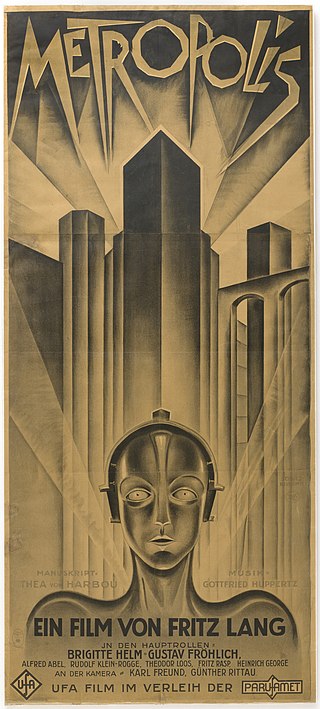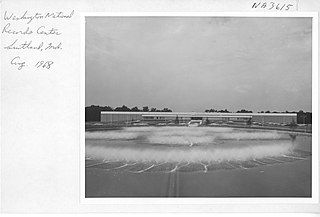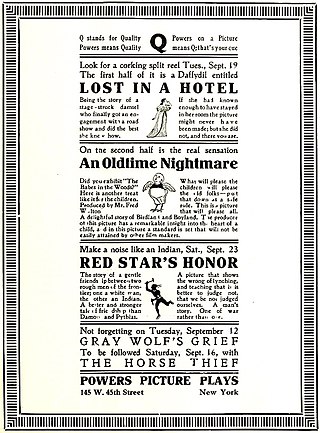Related Research Articles

Metropolis is a 1927 German expressionist science-fiction silent film directed by Fritz Lang and written by Thea von Harbou in collaboration with Lang from von Harbou's 1925 novel of the same name. It stars Gustav Fröhlich, Alfred Abel, Rudolf Klein-Rogge, and Brigitte Helm. Erich Pommer produced it in the Babelsberg Studio for Universum Film A.G. (UFA). Metropolis is regarded as a pioneering science-fiction film, being among the first feature-length ones of that genre. Filming took place over 17 months in 1925–26 at a cost of more than five million Reichsmarks, or the equivalent of about €21 million.

Nitrocellulose is a highly flammable compound formed by nitrating cellulose through exposure to a mixture of nitric acid and sulfuric acid. One of its first major uses was as guncotton, a replacement for gunpowder as propellant in firearms. It was also used to replace gunpowder as a low-order explosive in mining and other applications. In the form of collodion it was also a critical component in an early photographic emulsion, the use of which revolutionized photography in the 1860s. In the 20th century it was adapted to automobile lacquer and adhesives.

The National Archives and Records Administration (NARA) is an independent agency of the United States government within the executive branch, charged with the preservation and documentation of government and historical records. It is also tasked with increasing public access to those documents that make up the National Archives. NARA is officially responsible for maintaining and publishing the legally authentic and authoritative copies of acts of Congress, presidential directives, and federal regulations. NARA also transmits votes of the Electoral College to Congress. It also examines Electoral College and constitutional amendment ratification documents for prima facie legal sufficiency and an authenticating signature.

The 1947 Texas City disaster was an industrial accident that occurred on April 16, 1947, in the port of Texas City, Texas, United States, located in Galveston Bay. It was the deadliest industrial accident in U.S. history and one of history's largest non-nuclear explosions.

Film preservation, or film restoration, describes a series of ongoing efforts among film historians, archivists, museums, cinematheques, and non-profit organizations to rescue decaying film stock and preserve the images they contain. In the widest sense, preservation assures that a movie will continue to exist in as close to its original form as possible.

Cinema in Canada dates back to the earliest known display of film in Saint-Laurent, Quebec, in 1896. The film industry in Canada has been dominated by the United States, which has utilized Canada as a shooting location and to bypass British film quota laws, throughout its history. Canadian filmmakers, English and French, have been active in the development of cinema in the United States.

The National Film Archive of India (NFAI) was established as a media unit of the Ministry of Information and Broadcasting in February 1964. It was a member of the International Federation of Film Archives.

The National Personnel Records Center fire of 1973, also known as the 1973 National Archives fire, was a fire that occurred at the Military Personnel Records Center (MPRC) in the St. Louis suburb of Overland, Missouri, from July 12–16, 1973.

Universal Studios Hollywood is a film studio and theme park in the San Fernando Valley area of Los Angeles County, California. About 70% of the studio lies within the unincorporated county island known as Universal City while the rest lies within the city limits of Los Angeles, California. It is one of the oldest and most famous Hollywood film studios still in use. Its official marketing headline is "The Entertainment Capital of LA". It was initially created to offer tours of the real Universal Studios sets and is the first of many full-fledged Universal Studios theme park resorts located across the world.

A lost film is a feature or short film in which the original negative or copies are not known to exist in any studio archive, private collection, or public archive. Films can be wholly or partially lost for a number of reasons. Early films were not thought to have value beyond their theatrical run, so many were discarded afterward. Nitrate film used in early pictures was highly flammable and susceptible to degradation. The Library of Congress began acquiring copies of American films in 1909, but not all were kept. Due to improvements in film technology and recordkeeping, few films produced in the 1950s or beyond have been lost.

It's All True is an unfinished Orson Welles feature film comprising three stories about Latin America. "My Friend Bonito" was supervised by Welles and directed by Norman Foster in Mexico in 1941. "Carnaval" and "Jangadeiros" were directed by Welles in Brazil in 1942. It was to have been Welles's third film for RKO Radio Pictures, after Citizen Kane (1941) and The Magnificent Ambersons (1942). The project was a co-production of RKO and the Office of the Coordinator of Inter-American Affairs that was later terminated by RKO.
A film base is a transparent substrate which acts as a support medium for the photosensitive emulsion that lies atop it. Despite the numerous layers and coatings associated with the emulsion layer, the base generally accounts for the vast majority of the thickness of any given film stock. Since the late 19th century, there have been three major types of film base in use: nitrate, acetate, and polyester.
On August 10, 1965, a fire erupted in Vault 7, a storage facility at the Metro-Goldwyn-Mayer studio (MGM) backlot in Culver City, California. It was caused by an electrical short that ignited flammable stored nitrate film. The initial explosion reportedly killed at least one person, and the resulting fire destroyed the entire contents of the vault, which included archived prints of silent and early sound films produced by MGM and its predecessors. The only known copies of hundreds of films were destroyed.

The Washington National Records Center (WNRC) in Suitland, Maryland, stores and references records of U.S. Federal agencies located in the District of Columbia, Maryland, Virginia and West Virginia.

A major fire occurred in a 20th Century-Fox film-storage facility in Little Ferry, New Jersey, United States on July 9, 1937. Flammable nitrate film had previously contributed to several fires in film-industry laboratories, studios and vaults, although the precise causes were often unknown. In Little Ferry, gases produced by decaying film, combined with high temperatures and inadequate ventilation, resulted in spontaneous combustion.

It's All True: Based on an Unfinished Film by Orson Welles is a 1993 documentary film about Orson Welles's ill-fated Pan-American anthology film It's All True, shot in 1941–42 but never completed. Written and directed by Richard Wilson, Bill Krohn and Myron Meisel, the film is narrated by Miguel Ferrer. It was named the year's Best Non-Fiction Film by the Los Angeles Film Critics Association, and its filmmakers received a special citation from the National Society of Film Critics.

An Old-Time Nightmare is a lost 1911 American silent comedy-fantasy film. Directed by Fred Walton, the short was released as the latter half of a 1000-foot "split reel", with the first half being another comedy short, Lost in a Hotel. Both films were produced by the Powers Moving Picture Company of New York. This short's performers are not credited in 1911 reviews, in plot summaries, or in advertisements published in trade journals at the time. The faces of most of the cast were not visible on screen, for many of the actors wore costumes with full head coverings sculpted to resemble various species of birds, including a sparrow, eagle, dove, owl, wren, stork, bluebird, robin, linnet, and crow. While the short was identified upon its release as a comedy, it was also characterized in several contemporary reviews as a morality lesson and ideal photoplay for "juvenile" audiences.

Lost in a Hotel is a 1911 American silent comedy film. It was released as the first half of a 1000-foot "split reel", with the latter half being the comedy-fantasy short An Old-Time Nightmare. Both films, currently presumed to be "lost", were produced by the Powers Moving Picture Company of New York. Neither the director nor the performers in this film are identified in 1911 reviews or in plot summaries and advertisements published in trade journals at the time.

On the morning of June 13, 1914, a disastrous fire and a series of related explosions occurred in the main film vault of the Lubin Manufacturing Company in Philadelphia, Pennsylvania. Several possible causes for the blaze were cited at the time, one being "spontaneous combustion" of highly flammable nitrate film, which was the motion picture industry's standard medium for cameras throughout the silent era and for the first two decades of "talking pictures". Millions of feet of film were consumed in the flames, including most of the master negatives and initial prints of Lubin's pre-1914 catalog, several of the company's recently completed theatrical prints ready for release and distribution, a considerable number of films produced by other studios, inventories of raw and stock footage, hundreds of reels documenting historic events that occurred between 1897 and early 1914, as well as other films related to notable political and military figures, innovations in medical science, and professional athletic contests from that period. While this fire was not a decisive factor in Lubin's decline and bankruptcy by September 1916, costs associated with the disaster only added to the corporation's mounting debts, which led to the closure or sale of its remaining operations the following year.
References
- 1 2 "Historic Film Lost in Blaze - The Washington Post". The Washington Post . Retrieved 16 January 2022.
- 1 2 "Forty Years Ago, 12.6 Million Feet of History Went Up in Smoke - Smart News - Smithsonian Magazine" . Retrieved 16 January 2022.
- ↑ "Disaster Strikes the National Archives: The 1978 Nitrate Vault Fire – The Unwritten Record". 4 December 2018. Retrieved 16 January 2022.
- ↑ "National Archives and Records Service film-vault fire at Suitland, Md. : hearings before a subcommittee of the Committee on Government Operations, House of Representatives, Ninety-sixth Congress, first session, June 19 and 21, 1979 : United States. Congress. House. Committee on Government Operations. Subcommittee on Government Information and Individual Rights - Internet Archive". 1979. Retrieved 16 January 2022.